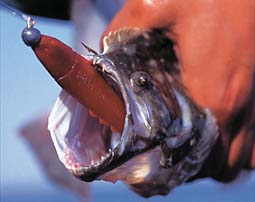Ten Fall Flounder Fundamentals
By Larry Bozka
 Target coves and flats areas near major passes. Top spots, to name a few, include Rollover Pass at East Galveston Bay, Seawolf Park above the Galveston Jetty channel, San Luis Pass at West Galveston Bay, the Freeport Jetties, the mouth of the Colorado River at Matagorda, Pass Cavallo at Port O'Connor, the Lydia Ann Channel at Port Aransas and the Land Cut between Baffin Bay and Port Mansfield. Target coves and flats areas near major passes. Top spots, to name a few, include Rollover Pass at East Galveston Bay, Seawolf Park above the Galveston Jetty channel, San Luis Pass at West Galveston Bay, the Freeport Jetties, the mouth of the Colorado River at Matagorda, Pass Cavallo at Port O'Connor, the Lydia Ann Channel at Port Aransas and the Land Cut between Baffin Bay and Port Mansfield.
- The presence of baitfish is no less critical to finding flatfish than it is to locating speckled trout and redfish. Difference is, mullet aren't the primary key. Anywhere you see small forage species, specifically menhaden, is a good potential flounder fishing hole.
- Remember that fall flounder tend to congregate in numbers and that they don't move about near as much as reds and trout. As such, always try to "pattern cast." Once you catch a fish, stay in place and thoroughly cover the surrounding area by placing your casts just to the side of the previous throw.
- The flounder "strike zone" is where the fish are, near the bottom. Work lures slowly and meticulously. Top offerings include soft plastics - shrimptails and shadtails, along with specialty lures like the split-tailed "Flounder Pounder" and "Flex Jig" - as well as quarter-ounce spoons. The Rapala Weedless Minnow Spoon is one of my favorites; this lure won a tournament for me back in fall of '95. A single-hooked Johnson Sprite can also be a real killer.
- If you're partial to natural baits, don't ignore the mud minnow, properly referred to as the "Gulf killifish." Mud minnows, unlike live shrimp, are not likely to attract trash fish like hardhead catfish and small croakers.
- When flounder are holding near marshy shorelines where grass can present a snagging dilemma, rig your baits below a float or popping cork. Throw the rig inside of coves and cuts, and let the current float it along the shoreline in order to cover as much bottom area as possible. Always set the leader length to present the bait a foot or so above the bottom.
- Give the fish a moment or two to take the lure or bait before setting the hook. Flounder will often "mouth" the offering before taking it in earnest.
- Use a landing net, even when wade fishing for flounder. The fish are notorious for short-striking, and accordingly will often barely get the barb in their mouth.
- For the same reason, play flounder gently. I've landed fish before that were not hooked, but instead were simply holding the bait in their mouths. Use an easy hand, and even flatfish like these can sometimes be netted before spitting the hook.
- If you're wade fishing and don't have a net, exercise extreme caution when hand-landing a flounder - especially if the bait in its mouth is a multi-trebled plug. The fishes' flat bodies make them tough to grab, and when you do grab them you can count on them going completely ballistic. Grab the fish immediately behind the gill flaps, and hold on with everything you've got. Finally, always run the stringer through the fish's jaws before letting go. Flounder are arguably the easiest-to-lose gamefish that swim in saltwater.
|





